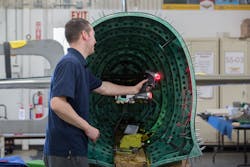Much has been made of a new technology that you’ve probably heard of or been watching as the future of design and manufacturing unfolds. Yes, I’m referring to 3-D printing (3-DP) or additive manufacturing. There’s no doubt that 3-DP certainly is developing impressively and efficiently as a very useful process for the future of manufacturing, however, it has large limitations in its current state of practical applications. Object’s physical dimensions, material specifications, and approvals for replacement to traditional processes, not to mention costs are just some of the current hurdles that will take more time to justify 3-DP as a routine process for most manufacturers.
In the meantime, what if I told you there was another 3-D technology available and with just as many applications, if not more, that happen on any given day at your typical aircraft maintenance hangar? The technology to which I am referring: 3-D laser scanning. What makes this innovation so practical and beneficial for the aerospace industry you ask? One word - measurement.
Before we dive right into what I mean by measurement, let’s take a step back and quickly define what a 3-D laser scanner is in addition to the various types of scanners that are available for service.
What is 3-D scanning?
3-D scanners are tri-dimensional measurement devices used to capture real-world objects or environments so that they can be remodeled or analyzed in the digital world. The latest generation of 3-D scanners do not require contact with the physical object being captured. 3-D scanners can be used to capture complete or partial 3-D measurements of any physical object. The scanner produces a digital, high-density mesh or point cloud that measures more accurately when compared to traditional measurement devices (think of rulers, calipers, micrometers, etc.). This data, or scan reference, is typically used for two main efforts: A) Inspections and B) Reverse engineering.
Does it matter what type of 3-D scanner I use?
Yes. If you divide the majority of 3-D scanning into two categories they would be defined as contact and non-contact scanning. Early technology; contact scanners have become rather antiquated because of their physical constraints and speed related to capturing data. These scanners are referred to as CMMs or coordinate measuring machines. For that reason I would like to put a larger emphasis on the most improved technology; non-contact 3-D scanning. These types of scanners own the most advanced features in scanning because they use features like structured light or lasers to retrieve and build data at amazing speed and accuracy. This is the point where users need to be aware or educate themselves on what their end goals are. Not all non-contact scanners are created equal. What I mean is, some scanners are well-suited to scanning large objects or areas while others have the precision to scan the depth of a scratch on aluminum. When you have a conversation with whomever is selling you scanning services, make sure they understand what problem you are trying to solve. By educating yourself, you can keep them honest about what their scanner can deliver. Not only may the accuracy of the scan be called into question, but also the physical limitations of the scanner to access an area to scan. That being said, non-contact portable 3-D laser scanners currently tend to be the most impressive technology, not only for their portable environment versatility,but also for their speed and accuracy in capturing data.
Alright, let’s circle back to that word I mentioned earlier - measurement. Yes, that’s what I want to emphasize because 3-D scanning is just very accurate digital three-dimensional measuring or metrology (the science of measurement). When you stop to think of this technology as just another way to measure it’s a little less intimidating, isn’t it? Measurements are taken for a reason; to inform subsequent decisions about what necessary steps need to be performed. If they are not recorded accurately, and in a timely manner, they can prove to be costly mistakes. By 3-D scanning, these errors can be vastly minimized to produce tangible savings both on the front end measuring, and at the back end when fabricated replacements fit perfectly the first time.
Now that we’ve explained why 3-D scanning is such a beneficial tool, let’s look at some specific applications in the aerospace industry that can benefit from its use.
Aircraft or aircraft part straightness/tolerance verification
Have you ever been involved in questions about an aircraft’s overall straightness? Has an aircraft’s landing gear or other parts integrity been called into question after a hard landing? By 3-D scanning these parts, or even an entire aircraft, measurements can be used to compare against known values to verify straightness. Maybe you manage a fleet of aircraft and one underperforms in performance at a given power setting, wouldn’t you like to know if it’s an aerodynamics issue? 3-D scanning specific areas on the aircraft to then be compared against the specified dimensions could prove very useful to verify that the aircraft is straight. Could 3-D scanning an aircraft for pre-buy inspections/or appraisals be applicable? Absolutely.
Corrosion inspection or wear comparison
Corrosion: The most reviled subject in any level of maintenance. Its detriment to aviation parts is particularly obvious, that’s why it is constantly focused on during inspection. Have you experienced situations measuring the corrosion depth only to find it too difficult to access? Or it’s at a point where approved repairs include fabricating a doubler or similar mating piece to increase the integrity of the area? 3-D scanning is a perfect solution to aid in the functions of measuring the corrosion depth. 3-D scanners on the market today advertise the accuracy within the scan of measurement to within +/- 0.002 inch. Do your existing measurement tools provide you that level of dimensioning while at the same time digitally documenting and easily formatting the data so it can be shared with engineers?
Damage assessments, including hail damage
When damage occurs to an aircraft, it grounds an otherwise airworthy aircraft that was scheduled to be in service. Hail impact damage inspection is a major time consumer for maintenance teams. Visual and manual inspections can be tedious and time-consuming to gather the proper dimensions related to the damage. 3-D scanning can capture the damage both accurately and much faster than traditional means. The MRO Lab, an Air France/KLM affiliate, has suggested inspection time can be cut from four to five hours per square meter to just 30 minutes per square meter, shortening inspection time by up to 80 percent. When you can quantify large segments of time it is easy to translate it into cost savings.
Reverse engineering skin contour for modifications or replacements
Implementing reverse engineering efforts utilizing 3-D scanning allows you to duplicate the scanned areas contour and convert that reference into a new, perfectly fitting part. We all know that almost everything on an aircraft has contour. Because of 3-D scanning's excellent ability to replicate these contours, tasks that can take hours to carefully measure on these surfaces can be captured in a matter of minutes by scanning.
Propeller shape comparison
Wouldn’t it be nice to know if overhauled propellers that still have vibrations are caused by balance or aerodynamic issues? 3-D scanning to the rescue. By 3-D scanning the props and comparing them to each other in software, differences in the shape of the props can be identified and specifically dimensioned so that machining efforts can be initiated to perfect the blade shapes.
Cabin interior measurement for retrofits or aftermarket product placement
When equipment that needs to be secured in an aircraft is supplied, rarely are digital models available for design and interference checking. 3-D scanning can provide the level of detail necessary for measuring these objects outer parameters, mounting holes, etc. This information is highly sought after by designers and engineers as a platform in order to launch new designs.
Tooling – Die & Mould design and modifications
Do you own tooling but lack documentation or drawings to properly fabricate new pieces once they have exceeded tolerance? 3-D scanning is a great way to capture that tooling and archive its dimensions so that it can be modeled in CAD again. In addition, 3-D scanning provides an excellent way to compare pieces that are fabricated against what was designed and specified in drawings (First Article Inspection).
Conclusion
While 3-D scanning does not receive the flashy publication like its 3-DP counterpart, hopefully you have gained insight on its practical applications in present day aerospace maintenance and manufacturing. In fact, it often serves as an efficient supplement to the 3-DP workflow. Remember, typically before you fabricate, manufacture or 3-D print something, you need a 3-D model. 3-D scanning provides the reference to develop a 3-D model that can serve as a new part made for prototyping, as well as reverse engineering a new replacement.
Investments in accurate 3-D scanning come at a cost premium. Purchasing a metrology grade scanner and training a technician to use it can near the six-digit expense. For this reason, companies have developed in order to provide 3-D scanning expertise as a service, much like other NDT contractors. By contacting them and discussing your potential applications, they can provide proposals for individual scanning projects. Again, these costs are typically higher because of the investment in the scanning equipment they use; however, when you compare OEM replacement part costs, or simple unavailability of parts, this technology is positioned as a perfect reverse engineering solution. When inspection processes are identified as time-consuming, most likely 3-D scanning will prove beneficial because of the time savings in speed of measurement. There’s that word again - measurement. Are you ready to start scanning?



